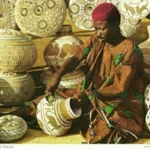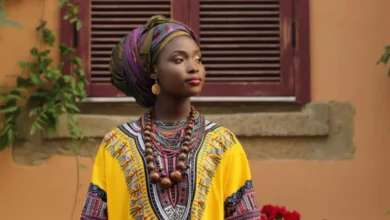Batik, a word derived from the Javanese word “amba” (to write) and “titik“ (dot), is far more than just a fabric; it’s a vibrant tapestry woven from centuries of Indonesian history, culture, and artistry.
This ancient textile art, recognized by UNESCO as a Masterpiece of the Oral and Intangible Heritage of Humanity, is a testament to Indonesia’s rich and diverse cultural landscape. This article will delve into the fascinating world of Indonesian batik, exploring its origins, techniques, symbolism, regional variations, and enduring significance.
The Origins and History of Batik
Pinpointing the exact origins of batik is challenging, shrouded as it is in the mists of time. However, evidence suggests that batik-making practices existed in Java as early as the 12th century. Early examples, often found in archaeological digs and historical texts, reveal simple geometric patterns. These early motifs likely held spiritual or symbolic significance, reflecting the beliefs and values of the time.
The art form flourished during the Majapahit and Mataram kingdoms, evolving from purely functional cloth to intricate works of art. Royal courts became significant patrons, commissioning elaborate batik pieces for ceremonial occasions and royal garments. This patronage significantly influenced the development of more complex designs and techniques, establishing batik as a symbol of status and power.
See also Beaded Calabash: A Deep Dive into African Tribal Art
Beaded Calabash: A Deep Dive into African Tribal ArtThe arrival of European traders in the 16th century further shaped the evolution of batik. The introduction of new dyes and techniques broadened the artistic possibilities, leading to the development of more refined and vibrant patterns. This period saw the flourishing of trade, with batik becoming a significant export commodity.
The 20th century brought both challenges and triumphs for batik. The rise of mass-produced textiles threatened traditional batik-making, but simultaneously, efforts to preserve and promote this unique art form gained momentum. Today, batik continues to thrive, adapting to modern trends while retaining its core traditions.

Batik-Making Techniques: A Labor of Love
Creating a piece of batik is a meticulous and time-consuming process, requiring immense skill and patience. The most traditional method involves using a canting, a small tool with a spout used to apply molten wax onto the fabric, creating intricate patterns. The wax acts as a resist, preventing the dye from penetrating the fabric in those areas.
The process typically involves several steps:
See also Algerian Traditional Clothing: A Blend of Berber, Arab, and Ottoman Influences
Algerian Traditional Clothing: A Blend of Berber, Arab, and Ottoman Influences- Preparing the fabric: This usually involves washing and stretching the fabric (typically cotton or silk) to ensure it’s smooth and taut.
- Waxing: The artisan meticulously applies the molten wax using the canting, following a pre-determined design or creating one spontaneously.
- Dyeing: The fabric is dyed, with the waxed areas resisting the dye. This process is repeated multiple times, using different colors and wax applications to achieve the desired effect.
- Removing the wax: Once the dyeing process is complete, the wax is removed by boiling the fabric or using a combination of boiling and scraping.
- Finishing: The final steps involve washing, drying, and sometimes pressing the fabric to give it a smooth finish.
In addition to the canting, another method involves using a cap or stamp to apply the wax. This technique allows for faster production, especially for larger or repeating patterns. However, the intricate detail achievable with the canting remains unmatched.

Symbolism and Meaning in Batik
Batik patterns are not merely decorative; they often carry deep symbolic meaning. The motifs used can represent a range of things, from nature and animals to religious beliefs and social status. For example:
- Flowers: Often represent beauty, purity, and femininity.
- Animals: Animals like birds, dragons, and elephants carry symbolic weight, often representing strength, power, or spiritual attributes.
- Geometric patterns: These can represent abstract concepts, social structures, or even cosmic order.
- Religious symbols: Many batik patterns incorporate religious motifs, reflecting the spiritual beliefs of the community.
Understanding the symbolism behind the patterns adds another layer of appreciation for the art form. The same pattern can have different meanings depending on the region, the artist’s intent, and the context in which it’s used. Many designs are passed down through generations, carrying with them the traditions and stories of their creators.
Regional Variations in Indonesian Batik
Indonesia’s vast archipelago boasts a rich tapestry of cultures, and this diversity is beautifully reflected in its batik traditions. Each region has its unique styles, patterns, and techniques, making the exploration of Indonesian batik a journey through the nation’s diverse heritage.
Javanese Batik
Javanese batik is arguably the most well-known, characterized by its sophisticated and refined designs. The patterns often feature intricate details, flowing lines, and a palette of earthy tones. Famous Javanese batik styles include Solo and Yogyakarta batik, each with its distinctive characteristics.
Madurese Batik
Madurese batik from Madura Island displays bold, geometric patterns and a vibrant color palette, often featuring bright reds, yellows, and blues. The designs are often simpler than Javanese batik, but they are no less striking in their visual impact.
Balinese Batik
Balinese batik reflects the island’s unique artistic sensibilities, often incorporating motifs inspired by nature and Hindu mythology. The designs are often lively and dynamic, with a strong emphasis on color and texture.
These are just a few examples of the many regional variations found throughout Indonesia. Other notable batik styles include those from Sumatra, Kalimantan, and Sulawesi, each with its own unique story to tell.
The Enduring Significance of Batik

Batik’s significance extends far beyond its aesthetic appeal. It is a living tradition, passed down through generations, preserving cultural heritage and promoting community bonds. The art form plays a vital role in Indonesian society, serving as a symbol of national identity and pride.
The intricate process of batik-making fosters a sense of community and collaboration. Many batik workshops operate as cooperatives, empowering local artisans and contributing to the economic well-being of their communities. The preservation of traditional batik-making techniques ensures the continuation of this invaluable cultural heritage.
Batik’s enduring popularity is evident in its continued use in modern fashion and design. Contemporary designers are incorporating batik patterns into clothing, accessories, and home décor, giving this ancient art form a new lease of life. This adaptation reflects batik’s timeless appeal and its ability to seamlessly integrate into modern aesthetics.
UNESCO’s recognition of Indonesian batik as a Masterpiece of the Oral and Intangible Heritage of Humanity underscores its global significance. This recognition not only celebrates the artistic excellence of batik but also highlights its cultural and social value. It serves as a call for continued preservation and promotion of this irreplaceable cultural asset.
Indonesian batik is more than just cloth; it’s a living testament to Indonesia’s rich and diverse cultural heritage. Its intricate designs, deep symbolism, and meticulous creation process make it a truly remarkable art form. As batik continues to evolve and adapt to the modern world, its enduring legacy remains secure, a source of pride and inspiration for generations to come.
Exploring the world of Indonesian batik is an enriching experience, revealing a fascinating journey through history, culture, and artistic expression. Whether appreciating its intricate designs, understanding its symbolism, or admiring the skill of the artisans, batik offers a captivating glimpse into the heart and soul of Indonesia.




